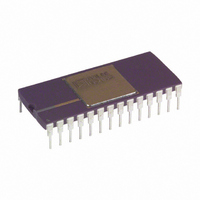AD569BD Analog Devices Inc, AD569BD Datasheet - Page 5

AD569BD
Manufacturer Part Number
AD569BD
Description
IC,D/A CONVERTER,SINGLE,16-BIT,BICMOS,DIP,28PIN
Manufacturer
Analog Devices Inc
Datasheet
1.AD569JNZ.pdf
(12 pages)
Specifications of AD569BD
Rohs Status
RoHS non-compliant
Settling Time
4µs
Number Of Bits
16
Data Interface
Parallel
Number Of Converters
1
Voltage Supply Source
Dual ±
Operating Temperature
-25°C ~ 85°C
Mounting Type
Through Hole
Package / Case
28-CDIP (0.600", 15.24mm)
Power Dissipation (max)
-
Lead Free Status / RoHS Status
Available stocks
Company
Part Number
Manufacturer
Quantity
Price
FUNCTIONAL DESCRIPTION
The AD569 consists of two resistor strings, each of which is di-
vided into 256 equal segments (see Figure 3). The 8 MSBs of
the digital input word select one of the 256 segments on the first
string. The taps at the top and bottom of the selected segment
are connected to the inputs of the two buffer amplifiers A1 and
A2. These amplifiers exhibit extremely high CMRR and low
bias current, and thus accurately preserve the voltages at the top
and bottom of the segment. The buffered voltages from the seg-
ment endpoints are applied across the second resistor string,
where the 8LSBs of the digital input word select one of the 256
taps. Output amplifier A3 buffers this voltage and delivers it to
the output.
Buffer amplifiers A1 and A2 leap-frog up the first string to pre-
serve monotonicity at the segment boundaries. For example,
when increasing the digital code from 00FF
segment boundary), A1 remains connected to the same tap on
the first resistor, while A2 jumps over it and is connected to the
tap which becomes the top of the next segment. This design
guarantees monotonicity even if the amplifiers have offset volt-
ages. In fact, amplifier offset only contributes to integral linear-
ity error.
CAUTION
It is generally considered good engineering practice to avoid
inserting integrated circuits into powered-up sockets. This
guideline is especially important with the AD569. An empty,
powered-up socket configures external buffer amplifiers in an
open-loop mode, forcing their outputs to be at the positive or
Definitions
LINEARITY ERROR: Analog Devices defines linearity error as
the maximum deviation of the actual, adjusted DAC output
from the ideal output (a straight line drawn from 0 to FS–1LSB)
for any bit combination. The AD569’s linearity is primarily lim-
ited by resistor uniformity in the first divider (upper byte of
16-bit input). The plot in Figure 4 shows the AD569’s typical
linearity error across the entire output range to be within
the AD569JN, AD and SD grades is specified to be 0.04%,
and 0.024% for the KN and BD versions.
REV. A
0.01% of full scale. At 25 C the maximum linearity error for
Figure 4. Typical Linearity
H
to 0100
H
, (the first
–5–
negative rail. This condition may result in a large current surge
between the reference force and sense terminals. This current
surge may permanently damage the AD569.
ANALOG CIRCUIT DETAILS
MONOTONICITY: A DAC is monotonic if the output either
increases or remains constant for increasing digital inputs. All
versions of the AD569 are monotonic over their full operating
temperature range.
DIFFERENTIAL NONLINEARITY: DNL is the measure of
the change in the analog output, normalized to full scale, associ-
ated: with a 1 LSB change in the digital input code. Monotonic
behavior requires that the differential linearity error be less than
1 LSB over the temperature range of interest. For example, for a
should result in a 152 V change in the analog output (1 LSB =
10 V/65,536). If the change is actually 38 V, however, the dif-
ferential linearity error would be –114 V, or –3/4 LSB. By leap-
frogging the buffer amplifier taps on the first divider, a typical
AD569 keeps DNL within 38 V ( 1/4 LSB) around each of
the 256 segment boundaries defined by the upper byte of the in-
put word (see Figure 5). Within the second divider, DNL also
typically remains less than 38 V as shown in Figure 6. Since
the second divider is independent of absolute voltage, DNL is
the same within the rest of the 256 segments.
OFFSET ERROR: The difference between the actual analog
output and the ideal output (–V
all zeros is called the offset error. For the AD569, Unipolar Off-
set is specified with 0 V applied to –V
specified with –5 V applied to –V
adjusting the voltage applied to the –V
BIPOLAR ZERO ERROR: The deviation of the analog output
from the ideal half-scale output of 0.0000 V when the inputs are
loaded with 8000
AD569, it is specified with 5 V applied to the reference
terminals.
5 V output range, a change of 1 LSB in digital input code
Figure 3. AD569 Block Diagram
H
is called the Bipolar Zero Error. For the
REF
REF
), with the inputs loaded with
. Either offset is trimmed by
REF
REF
and Bipolar Offset is
terminals.
AD569













